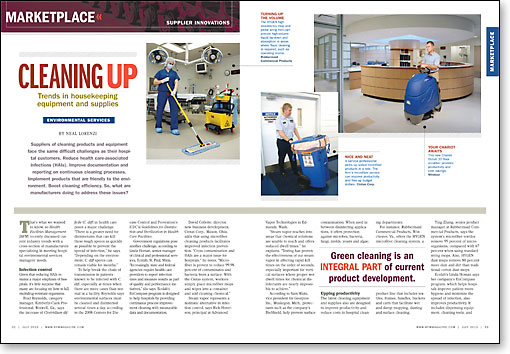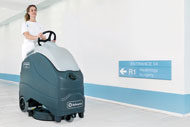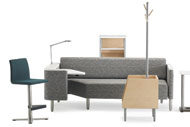Suppliers of cleaning products and equipment face the same difficult challenges as their hospital customers. Reduce health care-associated infections (HAIs). Improve documentation and reporting on continuous cleaning processes. Implement products that are friendly to the environment. Boost cleaning efficiency. So, what are manufacturers doing to address these issues?
That's what we wanted to know, so Health Facilities Management (HFM) recently discussed current industry trends with a cross-section of manufacturers specializing in meeting hospital environmental services managers' needs.
Infection control
Given that reducing HAIs remains a major emphasis of hospitals, it's little surprise that many are focusing on how to kill multidrug-resistant organisms.
Brad Reynolds, category manager, Kimberly-Clark Professional, Roswell, Ga., says the increase of Clostridium difficile (C. diff) in health care poses a major challenge. "There is a greater need for disinfectants that can kill these tough spores as quickly as possible to prevent the spread of infection," he says. "Depending on the environment, C. diff spores can remain viable for months."
To help break the chain of transmission in patients known to be infected with C. diff, especially at times when there are more cases than normal in a facility, Reynolds says environmental surfaces must be cleaned and disinfected several times a day, according to the 2008 Centers for Disease Control and Prevention's (CDC's) Guidelines for Disinfection and Sterilization in Health Care Facilities.
Government regulations pose another challenge, according to Linda Homan, senior manager of clinical and professional services, Ecolab, St. Paul, Minn. "Increasingly, state and federal agencies require health care providers to report infection rates and measure results as part of quality and performance initiatives," she says. Ecolab's EnCompass program is designed to help hospitals by providing continuous process improvement cleaning with measurable data and documentation.
David Collette, director, new business development, Cintas Corp., Mason, Ohio, adds that using microfiber cleaning products facilitates improved infection prevention. "Cross contamination and HAIs are a major issue for hospitals," he notes. "Microfiber is proven to reduce 99.98 percent of contaminates and bacteria from a surface. With the Cintas system, workers simply place microfiber mops and wipes into a container and add cleaning chemical."
Steam vapor represents a nontoxic alternative in infection control, says Rick Hoverson, principal at Advanced Vapor Technologies in Edmonds, Wash.
"Steam vapor reaches into areas that chemical solutions are unable to reach and offers reduced dwell times," he explains. "Testing has proven the effectiveness of our steam vapor in affecting rapid kill times on the order of seconds, especially important for vertical surfaces where proper wet dwell times for chemical disinfectants are nearly impossible to achieve."
According to Sam Waits, vice president for Geerpres Inc., Muskegon, Mich., protectants such as the company's BioShield, help prevent surface contamination. When used in between disinfecting applications, it offers protection against microbes, bacteria, fungi, molds, yeasts and algae.
Upping productivity
The latest cleaning equipment and supplies also are designed to improve productivity and reduce costs in hospital cleaning departments.
For instance, Rubbermaid Commercial Products, Winchester, Va., offers the HYGEN microfiber cleaning system, a product line that includes textiles, frames, handles, buckets and carts that facilitate wet and damp mopping, dusting and surface cleaning.
Ying Zhang, senior product manager at Rubbermaid Commercial Products, says the system's microfiber textiles remove 95 percent of microorganisms, compared with 67 percent when using standard string mops. Also, HYGEN dust mops remove 80 percent more dust and dirt than traditional cotton dust mops.
Ecolab's Linda Homan says her company's EnCompass program, which helps hospitals improve patient room hygiene and minimize the spread of infection, also improves productivity. It includes dispensing equipment, cleaning tools, and cleanliness monitoring and reporting tools. In pilot trials, health care providers that used the program were able to reduce terminal room cleaning times by 15 percent, enabling them to accommodate more patients, she says.
Stand-on floor scrubbing also represents an effective way to improve productivity in hospitals, according to Richard Bodo, director of business development for Windsor, Englewood, Colo. "Designed for extra maneuverability, these scrubbers allow staff to clean areas that currently must be mopped by hand with a conventional scrubber. Also, riding a machine versus walking behind it makes the worker more productive."
Windsor offers a 20-inch stand-on floor scrubber called the Chariot iScrub 20 that features a pivoting squeegee that picks up water in tight turning radii. The vendor says it saves 58 percent in operational costs compared to a conventional 17-inch scrubber, 40 percent compared to a 20-inch walk-behind scrubber, and 33 percent compared to a 26-inch walk-behind scrubber. The recovery tank is removable for replacement or cleaning.
Cincinnati-based Procter & Gamble Professional can help cleaning staff maximize efficiency through multipurpose solutions that ensure both cleaning and disinfecting needs are accomplished in one easy step. For instance, Comet Disinfecting Bathroom Cleaner is offered for wet surfaces, while Spic and Span Disinfecting Spray and Glass Cleaner is available for dry surfaces. The manufacturer says both hospital-grade disinfectants eliminate a broad spectrum of germs, including the influenza A virus and other pathogens.
Collette of Cintas says the microfiber service that his company offers also can improve productivity and free up budget dollars. "Environmental services (ES) departments are under constant pressure to operate with limited budgets and resources," he notes. "By using microfiber services, hospitals can focus on the core of their cleaning responsibilities. It frees up budget dollars so ES directors can add staff or make other capital investments. In addition, using such a program limits liability and risk."
Hospitals also can improve productivity by using vacuum cleaners featuring high-efficiency particulate air (HEPA) filtration, a practice that also offers Leadership in Energy and Environmental Design (LEED) points, according to Jacalyn High, marketing manager at ProTeam, Boise, Idaho. One such product is ProTeam's Super HalfVac vacuum, which features five-level filtration to maximize dust capture and retention. An additional HEPA filter captures carbon dust and indoor pollutants measuring 0.3 microns and larger.
Sustainable practices
Indeed, so-called "green cleaning" is another integral part of current product development, according to manufacturers. Major goals include reducing chemical use and water consumption, eliminating harmful emissions and cutting down on waste that would otherwise be dumped in landfills.
"The landscape of cleaning in health care is changing rapidly, and the new tools and standards of the trade are helping hospital workers and patients breathe a little easier," says ProTeam's Jacalyn High. "An important factor is the expected launch of the LEED for Health Care certification program by the U.S. Green Building Council."
According to High, recent studies suggest that hospital cleaning often is an environmental hazard rather than a help. "An April 2009 report by a Health Care Research Collaborative called Cleaning in Health Care Facilities: Reducing Human Health Effects and Environmental Impacts found that 'conventional cleaning products and disinfectants bring a host of other health hazards despite their capacity to fight against multidrug-resistant organisms.'"
Jacquel Kelly, senior marketing manager for the health care segment at Georgia-Pacific Professional, Atlanta, is another proponent of the green cleaning revolution. "By participating in sustainable practices, hospitals are emerging as more environmentally friendly, while continuing to focus on enhancing patient safety and satisfaction," Kelly says.
"Our enMotion and Brawny Industrial brands are just two examples of Georgia-Pacific Professional's many product solutions that support this growing trend for environmental sustainability," she adds. "Georgia-Pacific Professional's enMotion roll towel features recycled content that meets Environmental Protection Agency (EPA) guidelines of 40 percent post-consumer fiber. In fact, enMotion dispensers are part of Georgia-Pacific Professional's Green by Design program, a designation that highlights products that contribute to source reduction and helps customers attain LEED certification."
Similarly, Kimberly-Clark's Reynolds says, "To promote green cleaning, active ingredients in our KIMTECH One-Step Germicidal Wipes ultimately decompose into three environmentally safe compounds: water, oxygen and vinegar."
Indeed, the green movement has become so pervasive that every manufacturer interviewed had something
to say on the subject.
Regarding Rubbermaid's HYGEN product, for instance, Zhang says: "Because HYGEN lasts longer than traditional cleaning tools, there is less waste sent to landfills. The system also reduces chemical and water consumption by 95 percent and 90 percent, respectively."
Likewise, Advanced Vapor Technologies' Hoverson touts the small amounts of water and electricity used in the manufacturer's steam vapor cleaning and disinfection process and Windsor's Bodo discusses the iScrub 20's Aqua-Mizer system, which uses less water and chemicals than conventional scrubbers.
Finally, manufacturers say the proliferation of microfiber products also contributes to environmental performance.
"Microfiber is a green cleaning program that reduces chemical use by 95 percent," Collette of Cintas explains. "The chemical solutions consist mostly of water. The program also helps improve air quality due to a decrease in chemical evaporation."
Ultimately, however, Barbara Richter, health care center of excellence leader, Procter & Gamble Professional, cautions that all green product claims should be carefully evaluated.
"While no disinfectant on the market can claim to be a 'green product' because of EPA Federal Insecticide, Fungicide and Rodenticide Act regulations, the EPA is initiating a pilot program to test whether to allow disinfectant manufacturers to make green claims," she says.
Neal Lorenzi is a freelance writer based in Mundelein, Ill.
| Sidebar - For more information |
| For information on the equipment and supplies discussed in this month's "Marketplace" article, readers should contact the following manufacturers: Advanced Vapor Technologies Cintas Corp. Ecolab Geerpres Inc. Georgia-Pacific Professional Kimberly-Clark Professional Procter & Gamble Professional ProTeam Rubbermaid Commercial Products Windsor |





